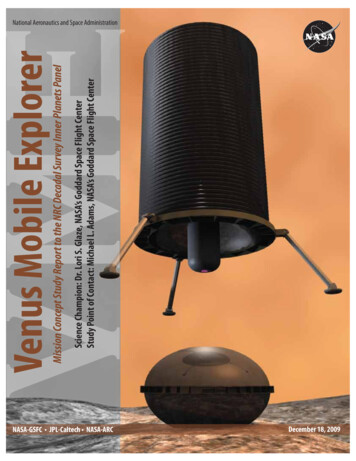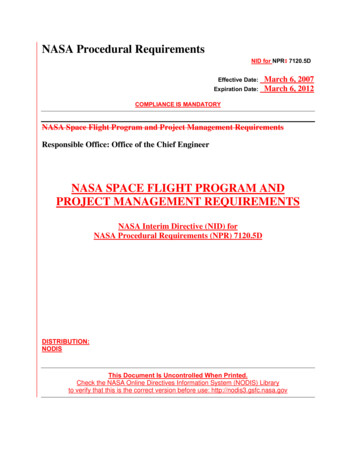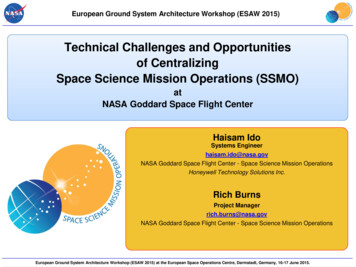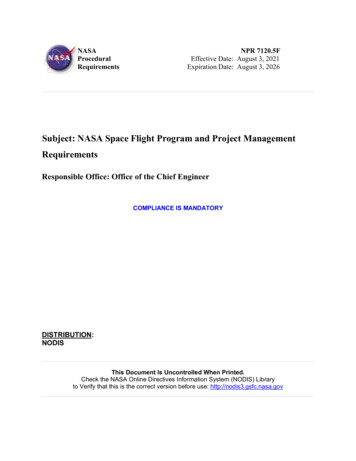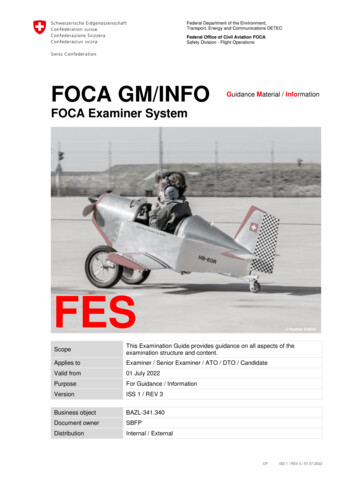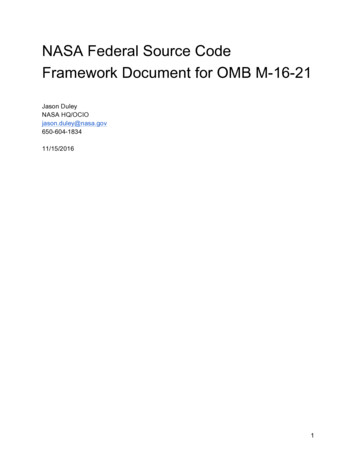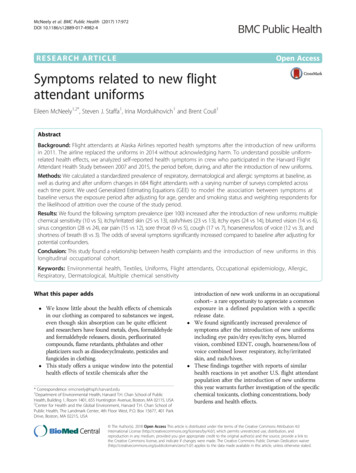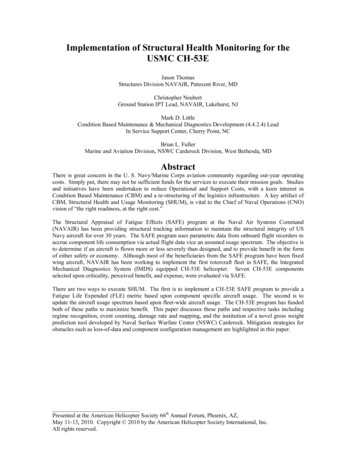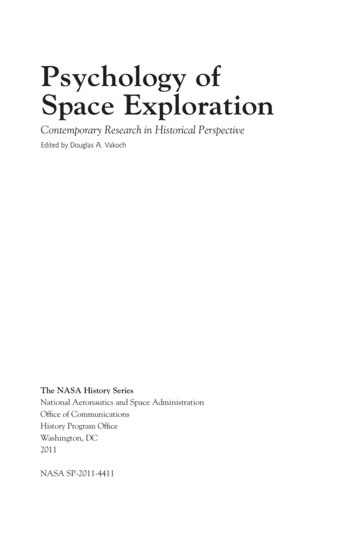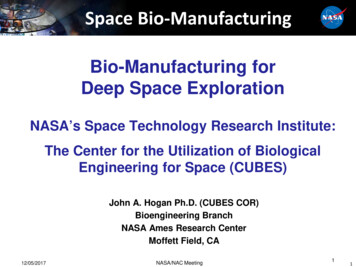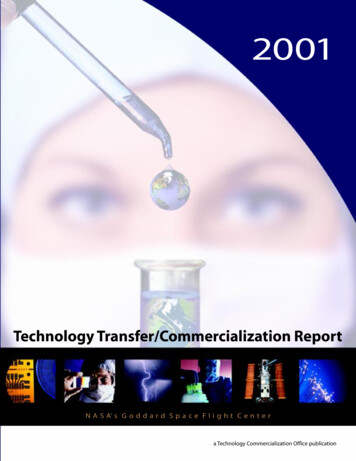
Transcription
2001Technology Transfer/Commercialization ReportN A S A’ s G o d d a r d S p a c e F l i g h t C e n t e ra Technology Commercialization Office publication
2 0 0 1N A S A’ s G o d d a r d S p a c e F l i g h t C e n t e rTechnologyTransfer/CommercializationR E P O R TSince its inception, NASA’s Goddard Space Flight Center has pursued a commitment totechnology transfer and commercialization. For every space technology developed, Goddard strivesto identify new ways it can be used. Goddard then makes these technologies, as well as its facilities andexpertise, available to U.S. companies, universities, and government agencies. These efforts are based inGoddard’s Technology Commercialization Office (TCO).This report presents TCO’s activities and accomplishments during calendar year 2001.Tableof ContentsWho We Are 2Activities in 2001 6Encouraging ResearcherInvolvement 7Inventorying New Technologies 8Patenting Goddard Technologies 14Promoting Goddard Technologies 15Seeking and Bestowing Awards 20Establishing New Agreements 23How to Reach Goddard’s Technology Commercialization Office 24
Who We AreTechnology transfer and commercialization arean important part of Goddard Space Flight Center’smission. They enable Goddard’s technology,facilities, and expertise—all of which are nationalassets—to be used in developing new productsand processes that benefit the United States. Thesebenefits include enriching the lives of the citizenry,creating new jobs, increasing the Nation’s competitiveness in the global market, and improvingthe balance of trade. To ensure that thesebenefits are achieved, Goddardestablished the TechnologyCommercializationOffice.4NASA’s Goddard Space Flight Center
TCO helps Goddard achieve its technology transfer/commercialization goals bywSeeking out new Goddard technologies that might meetindustry and national needswInventorying these newly developed technologieswPatenting Goddard-developed technologieswPromoting Goddard technologies, facilities, and capabilities topotential partnerswNegotiating license agreements and partnerships with industry,academia, or government agencieswPromoting successful transfer and commercialization effortsThese key activities are performed by four teams that work together to facilitate technology transfer and commercialization.20 01 Techn ology Tra nsfer/Commercialization Rep or t5
Commercial Technology StaffThe commercial technology staff works with industry, academia, and other government agencies to transfer Goddard technologies and to help these organizationssolve their technical problems within the six areas of Goddard’s technology commercialization expertise:wwwwwwEnvironmental systemsGuidance, navigation, and controlInformation systemsOpticsSensors and detectorsThermal and cryogenicsThe staff also negotiates licensing or partnership agreements.Outreach and Integration StaffThe outreach and integration staff markets Goddard-developed technologies thatare available for commercialization and publicizes successful commercializationefforts. These outreach efforts are conducted using Technology Opportunity Sheets;NASA Tech Briefs; Commerce Business Daily; the Internet; press releases; articlesin trade and news journals; and presentations at conferences, technology briefings,and trade shows with industry. For more information on these efforts, see pages15–19.The staff also works to integrate Goddard researchers into the commercializationprocess. For more information on these efforts, see pages 7 and 20–22.6NASA’s Goddard Space Flight Center
Small Business InnovationResearch StaffExtra efforts to involve smaller businesses are made underthe auspices of the Small Business Innovation Research (SBIR)and Small Business Technology Transfer (STTR) programs:wThe SBIR program was established by Congress in 1982to provide increased opportunities for small businessesto participate in research and development (R&D), toincrease employment, and to improve U.S. competitiveness. The program’s specific objectives are to stimulate U.S. technological innovation, use small businessesto meet federal R&D needs, increase private-sector commercialization of innovations derived from federal R&D, and foster and encourage participation by sociallydisadvantaged businesses.wThe STTR program awards contracts to small business concerns for cooperativeresearch and development with a nonprofit research institution, such as a university. The goal of the STTR program is to facilitate the transfer of technology developed by research institutions through the entrepreneurship of small businesses.The small business and its partnering institution are required to sign an agreementon how intellectual property will be shared between them.Patent CounselGoddard’s Office of Patent Counsel prepares patent applications and otherpatent-related documents, and it reviewsSpace Act, license, and nondisclosureagreements. Patent counsel also helpsdetermine the patent potential of newGoddard technologies and oversees intellectual property issues.20 01 Techn ology Tra nsfer/Commercialization Rep or t7
Activities in 2001The Technology CommercializationOffice’s mission is to introduceGoddard technologies, capabilities, andfacilities into the commercial, academic,and government communities. To achievethis mission, TCO undertakesmany activities:8wEncouraging researcher involvement in the technologycommercialization processwInventorying new technologies developed at GoddardwPatenting Goddard technologieswPromoting available technologies and facilitieswSeeking and bestowing awards for Goddard technologieswEstablishing new agreements with industry, academia,and other government agenciesNASA’s Goddard Space Flight Center
Encouraging Researcher InvolvementTechnology transfer and commercialization would not be possible without the participationof Goddard’s scientific and technical staff. Throughout the year, the Technology Commercialization Office encourages researcher participation. For example, in June TCO organized theGoddard Technology Showcase 2001, which featured Goddard-developed inventions (see page18). Events such as this and other TCO efforts encourage civil servant researchers to disclosetheir new inventions to TCO (see pages 8–13) and to participate in commercialization efforts.As a result of TCO’s efforts, the following civil servant researchers participated in the technology transfer/commercialization process:Wes AlexanderSteven BaileyJeannette BenavidesGeoffrey BlandGregory BoegnerGregory ClarkeMichael ComberiateJulie CrookeJeff de La BeaujardiereMichael DelmontJulie DeutschmannJeffrey DidionMichael DipirroNga DoanJohn DonohueWarren DufreneChris DurachkaBernard EdwardsHoward EiserikeWayne EsaiasNelson FerragutThomas FlatleyBo-Cai GaoRegina GernattDorothy HallPrasad HanagudRichard HarmanAmri Hernandez-PelleranoEllen HerringFrank HogeNorden HuangJeremy JonesYoram KaufmanMichael KingTodd KingSemion KizhnerJohn KolasinskiBrook LakewJim LanziMichael LeeHenning LeideckerJesse LeitnerDonald LokersonPhilip LuersMark LupisellaRichard LuquetteChristopher LynnesLori MaksTed MilesDwayne MorganSteve NausBrian OttensBarbara PfarrRobin PfisterJay PittmanWilliam PotterCharles PowersLloyd PurvesGlenn Rakow20 01 Techn ology Tra nsfer/Commercialization Rep or tLorraine RemerJohn RileyAaron RobertsDavid RobinsonAdan Rodriguez-ArroyoKurt RushAngela RussoVincent SalomonsonPeter ShirronJoel SimpsonJames TiltonDavid TracewellTina TsuiDana UehlingJohn VanSantJohn VranishEugene WaluschkaEvan WebbMiriam WennerstenDavid WhitemanEdward WollackEve WooldridgePen-Shu Yeh9
Inventorying New TechnologiesOne of the primary ways that Goddard researchers participate in thetechnology transfer process is by identifying, documenting, and reportingtheir new technologies to the Technology Commercialization Office. TCOthen maintains an inventory of these reported technologies. Pages 8–13list all of the technologies reported in 2001, categorized according toGoddard’s areas of technical expertise. For more information about thesetechnologies, please contact the commercial technology staff member forthe corresponding technical area (see page 24).Sensors and DetectorsA Very Low Power, Highly Integrated Multichannel Scaler (USB)Area of Interest Selection Circuit for Image Sensor and/orPosition Sensing DetectorC8051 ResynthesisElectrical Resistivity Measurements on Conductive Spacecraft FilmsField-Programmable Analog Array (FPAA) ArchitectureGeneric High Side Solid-State SwitchGermanium Strip Detector System for X-ray and Gamma RaySpectrometry and ImagingHigh-Density Passive Component ArraysImproved Reducing Gas Detector for Carbon Monoxide and OtherReducing GasesInstrument Synthesis and Analysis Laboratory (ISAL)Magnetohydrodynamic Stable Reference (MSTAR)Micro Sun Sensor Using HologramResynthesisSelf-Assembled Silicon Nanostructures by Magnetron SputteringVLF Lightning Location SystemX-Band Solid State Power Amplifier (SSPA)10NASA’s Goddard Space Flight Center
Environmental SystemsAncillary Data Preprocessing Software for Moderate Resolution ImagingSpectroradiometer (MODIS) Ocean Product GenerationAnemometer for Low Velocity Wind MeasurementsDigital Earth Web Map ViewerEnhanced Land Cover and Land Cover Change Products from MODISEstimating Global Vegetation Production: Algorithms MOD17A1 andMOD17A2Flight ModemLarge Format X-Ray Magnetic Calorimeters with Multiplexed SQUIDReadoutsLevel 1A and Geolocation Software for MODISLevel 1B (Calibrated Radiances) Software for MODIS Data ProcessingLevel 2G Gridding Software for MODIS Land Product GenerationMethod for Efficient Parallel Execution of Finite Element AnalysesMODIS Aerosols Over Land And OceanMODIS Atmosphere Level-3 Algorithm SoftwareMODIS Cloud Optical Properties Algorithm (MOD PR06OD)MODIS Near-IR Water Vapor Algorithm, and MODIS Thin CirrusReflectance AlgorithmMODIS Ocean Primary ProductionMODIS Reprojection ToolMODIS Snow and Ice MapsMODIS Vegetation Index AlgorithmsMulti-Application Gbit/sec Real-Time Data Recording/Playback SystemOcean Processing Software for NASA’s MODISProduct Distribution System (PDS) Integration with Earth ObservingSystem Data and Information System (EOSDIS) Core System (ECS)Sea Surface Salinity for Autonomous SystemsSimple Scalable Script-Based Science Processorfor Direct Broadcast (S4P-DB)Skymap Sky2000 Master Star Catalog Dump Utility MCDUMPSoftware for Atmospheric Correction of MODIS Visible:Shortwave Infrared DataSoftware for Fire Monitoring from MODISSoftware to Calculate Phytoplankton Fluorescence Propertiesfrom MODIS DataSoftware to Estimate Vegetation Canopy Leaf Index (LAI)Surface Albedo, Bidirectional Reflectance, and Land Cover TypeDerived from MODIS DataUltrastable Radiometer for Sea Surface Salinity SensingWireless Information Peer Relay System20 01 Techn ology Tra nsfer/Commercialization Rep or t11
Information SystemsAction Item SystemAdaptation of Ethernet Network Technology for Low-Power,Radiation Tolerant Spaceborne UseAnalog Artificial Neural NetworkAnomaly Reporting and Tracking ToolCHDLComputer Program for Automatic Code Generation andDocumentation of Dynamic System ModelsDepletion MuxDistributed Beowulf System for Low-Cost, MassivelyParallel ProcessingHazard Free Standard Cell Pass Transistor NetworksHigh Bandwidth Network Router for Local Area NetworkUsing SpaceWireHuang-Hilbert Transform Data Processing SystemIndependent Verification and Validation (IV&V) Tools Includingthe TestManager 2000 (TM2000), Project Issue TrackingSystem (PITTS), and Risk ManagementInfrared for Intra-Satellite Communications for Space ApplicationsKernel Cell Layouts for Assembly into Standard CellsKnowledge System for COTS/GOTS Ground SystemKnowledge-Based Architecture for Distributed Modeling andSimulation of SpacecraftMercury-A Web-Based Metadata Search and Data Retrieval SystemMethod for Lossless Compression of Real or Complex ValuedScientific DataMethod for Recursive Hierarchical Segmentation Combining Greedyand Hierarchical Stepwise Optimal Approaches and Region SplittingMux-Based Logic Optimization ProgramsMux-based ROM Using N-Bit Subfunction EncodingMux-Based Standard Cell Library Assembly ProgramMyISC/My GoddardNASA Property Disposal Management SystemPartitioned VLSI LayoutPrototype Video-Indexing SystemQDoc: A Documentation and Presentation Tool for the FORTRANProgramming LanguageREACH: Realtime Evaluation and Analysis of Consolidated HealthSatellite Supported Voting System (SVS)Software for the 3-D Display of Spacecraft and Other Time SeriesData, Using Java3DSWARM: Sensor Web Adaptive Resource ManagementSynthesizable VHDL ModulesTime-Modulated Ultra-Wideband Interspacecraft Communication12NASA’s Goddard Space Flight Center
U8 LayoutsUniversal Logic Gate AlgebraUniversal Logic Gate LibraryUser Interface Component Broker SoftwareVisual Observation Layout Tool (VOLT)Wearable Voice-Activated ComputersGuidance, Navigation, and ControlAdaptive Beamforming on Spacecraft to Improve GlobalPositioning System (GPS)Autonomous Low-Power Datalogger Package with 24 Bit A/D’s,GPS, Rate Sensors, 12 Bit A/D, Serial Lines and SensorIntegration CapabilityAutonomous Navigation System Based on GPS and MagnetometerData (GPS-MAGNAV)Bistatic Delay Doppler Radar AltimeterClosed-Loop Automated Ground Data System for Support of theMMS (STP) ConstellationsCompact Scalable Navigation and Stabilization System for Spectral ImagersCrosslink Transceiver for Integrated Navigation and Communicationamong Multiple, Distributed SpacecraftDistributed Spacecraft Modeling and Simulation TestbedFlightLinux SoftwareFormation Flying Testbed System ArchitectureGlobal Positioning System Software ReceiverHardware and Software Implementation of Noncoherent Navigationfor Low Frame Rate Telemetry ApplicationsLow-Power Balloon-Gondola Solar Pointing SystemMultimission Attitude Determination System (ADS-MATLAB)Open GIS Consortium (OGC) Catalog PrototypeRadiation Hard CMOS APS Circuits for Star TrackerSingle Event Latchup Mitigation in Commercial MicroelectronicsST-5 Quadrifiler Helical AntennaX-Band Transponder For Microsatellites20 01 Techn ology Tra nsfer/Commercialization Rep or t13
Thermal and CryogenicsCryogenic Advanced Loop Heat Pipe in Temperature Range of 20–30 KElectrohydrodyanamic Microscale PumpMixed Conductor Electrodes for Alkali Metal Thermal-to-Electric ConvertersOxide Conversion Joints for Alkali Metal Thermal-to-Electric ConvertersPassive Gas-Gap Heat Switches for Use with Adiabatic DemagnetizationRefrigeratorsRare-Earth Garnets for Space-Based ADR Cooling at High Temperature(4K T 30K) and Low Magnetic Fields (H 4T)Switched Emissivity Changes via Electrostatic AttractionUsing Incremetal Vacuum Lifts PayloadsOpticsA Novel Pupil for Detecting Faint Objects in the Presenceof a Bright SourceBragg Mirrors for Long Wavelength VCSEL AEye Safety Camera Attached to Theodolite to Obtain Boresight Pointing ofHigh Intensity Visible Lasers and/or Invisible Infrared LasersGroup-Velocity Mismatching Compensation for Optical Signal ProcessingHigh-Resolution X-ray CollimatorsHolographic Plossl RetroreflectorIn Situ Monitoring Method and Apparatus for Fabricating DoublyMult-plexed Holograms in the Same Photopolymer FilmsLaser Power Stabilization Feedback SystemMulti-Point In Situ Profiler for Large Aspheric OpticsMultispot Beam Steering System and Applications ThereofRugged Iris MechanismScientific Method to Coat High Magnesium Aluminum AlloysSimpleStructure with High Number Density of Carbon Nanotubesand 3-Dimensional DistributionStripping Fixture for Wire Ribbon CablesWaveguide Structure for Efficient Difference-Frequency GenerationX-ray Mirror Replicas from Structural Nanolaminate Composites14NASA’s Goddard Space Flight Center
Other TechnologiesAnti-Backlash Gear-BearingsFinite Rotation Analysis of Highly Thin and Flexible StructuresHalf-Tooth Gear BearingsMagnetic Bearing Structure and Control for Low Power Consumption,Low Weight and Fault Detection and Tolerant OperationMembrane Technology for Gossamer Spacecraft StructuresMethod of Making Multi-Stub Data Busses Such as theMIL-STD-1553B Very Compact and Other EmbodimentsThat Can Use This New PerspectiveMethod for Manufacturing High-Quality Carbon NanotubesMethods to Maximize Microgravity Time on ParabolicAircraft FlightsMiniature Sample Acquisition and Handling MechanismNew Method for Synthesizing Cubic Boron Nitride FilmsNitrous Oxide/Organic Liquid Monopropellant (NOMR)Oxide Barrier VaractorPhase-Tuned GearsRotating Pair Programming DeskScrew-Locking WrenchShaftless Maglev Flywheel Energy Storage SystemStepping FlexuresUse of a Scanning Probe Microscopy (SPM) Height Assay to DetectProtein:DNA and Protein:Protein Interactions on CompositionallyPatterned Surfaces20 01 Techn ology Tra nsfer/Commercialization Rep or t15
Patenting GoddardTechnologiesA key activity of the Technology Commercialization Office’s Patent Counsel team isprotecting Goddard’s intellectual property (IP). Because filing for and maintaining apatent can be costly, counsel carefully evaluate new technologies to ensure that filingfor a patent is appropriate. During 2001, the Patent Counsel team filed 23 patent applications, 16 of which were provisional patents. Provisional patents provide temporarypatent protection for 1 year. They are useful for protecting patent rights while decisionsare made about whether to file for full patent protection. They also are useful forprotecting IP rights while allowing the inventors to disclose the technology at a conference or other event.In addition to the patent filings, 12 Goddard technologies received patents in 2001:U.S. Patent No.16Technology Name6,287,404Adhesive Bubble Removal Technique and Fixturefor Fiber Optic Applications6,178,470Chip for CCSDS-Compatible Serial Data Streams6,188,705Fiber Grating Couple Light Source Capable ofTunable Single Frequency Operations6,278,404Global Positioning System Satellite Selection Method6,313,908Holographic Circle-to-Point Converter6,313,555Low Loss Pole Configuration for Multi-PoleHomopolar Magnetic Bearings6,182,011Method and Apparatus for Determining PositionUsing Global Positioning Satellites6,177,835Method and Apparatus for High Data Rate Demodulation6,223,143Quantitative Risk Assessment Software (QRAS) System6,177,997Shaft Position Optical Sensor6,211,822Spaceborne Global Positioning System for Spacecraft6,311,130Two-Dimensional Empirical Mode Decompositionand Hilbert Spectral Analysis for Image ProcessingNASA’s Goddard Space Flight Center
Promoting GoddardTechnologiesThe Technology Commercialization Office promotes Goddard’s innovativetechnologies and unique facilities through publications and conferences,briefings, and trade shows with industry.TechnologyOpportunity SheetsThese one-page announcements succinctlysummarize a Goddard-developed technology, focusing on its potential commercialapplications and benefits. The TechnologyCommercialization Office prepares thesesheets and distributes them through targeted mailings, at trade shows, and viaTCO’s Web site.http://techtransfer.gsfc.nasa.gov20 01 Techn ology Tra nsfer/Commercialization Rep or t17
NASA Tech BriefsThis monthly periodical helps NASA achieve its technology transfer goals by reporting new, commercially significant NASA technologies. NASA Tech Briefs subscribers—industry engineers, managers, and scientists—thus learn about opportunities tolicense, transfer, and/or commercialize NASA technologies or to partner with NASAon joint research. Goddard’s Technology Commercialization Office wrote 15 articlesfor NASA Tech Briefs in 2001:wBroad-Band, Noninvasive Radio-Frequency Current Probe (GSC-13985): Thiscircuit responds in approximately constant proportion to current over a widefrequency range.wDouble-Parallelogram Carriage for Spectrometer Mirrors (GSC-14297): Linearmotion is derived from motions of coupled, pivoted arms.wFlex Wedges (GSC-14006): Brakes and clutches could perform more reliably andpredictably.wFourth-Generation Software for SEU Testing (GSC-14399): This computerprogram tests electronic components for single-event upsets.wHolographic Circle-to-Point Converter (GSC-13869): Fabry-Perot interferencefringes are focused to points for efficient detection.wImproved Automated System for Transferring Liquid Helium (GSC-14106):Consumption of liquid helium would be reduced by optimizing use of vapor forprecooling.wImproving Thin Foil X-Ray Mirrors (GSC-14043): Resolution and diameter wouldbe increased.wLow-Power Shutter Mechanism for a Cryogenic Infrared Camera (GSC-14341):The time-averaged power dissipation is less than 5 megawatts.wMiniature Proportional Temperature Controllers (GSC-14315): These would besmaller and lighter than their commercial predecessors.wProcess for Polishing Bare Aluminum to High Optical Quality (GSC-14147):India-ink polishing following single-point diamond turning yields superioraluminum optics.wShared-Aperture Multiplexed Holographic Scanning Telescopes (GSC-14240):This technology achieves full-aperture scanning without moving parts.wSoftware for Rapid Processing and Display of Earth Data (GSC-14263): Thisprogram facilitates retrieval and viewing of Earth-related imagery on computerscreens or virtual-reality displays.wSpin Bearings (GSC-13679): These bearings offer advantages with respect toload-bearing capacity, retention of alignment, and size.wTailoring Cores of Optical Fibers by a Sol-Gel Method (GSC-13913): Coredopants can be tailored for specific photonic applications.wThermal-Stress Technique for Cutting Thin Glass Sheets (GSC-14364): Highlylocalized heating generates highly localized stresses.NASA Tech Briefs is available on the Internet.http://www.nasatech.com18Reprinted with permission from NASATech Briefs, Volume #25, Nos. 1, 6, 7, & 9.NASA’s Goddard Space Flight Center
Conferences, Briefings, andTrade Shows with IndustryThe Technology Commercialization Office also disseminatesinformation about its inventions and their potential commercial applications by hosting and attending conferences, briefings, and trade shows with industry. At these events, staffdemonstrate technologies, distribute informative literature,and offer one-on-one counseling to industry about partnership and commercialization opportunities at Goddard.Through these events, TCO successfully reached many smalland large companies, academic institutions, and trade andprofessional organizations during 2001.Air and SpaceInternational Space SymposiumSmall Business and EconomicDevelopmentEmerging Business ForumEducation and EnvironmentAssociation of University TechnologyManagers Annual MeetingGoddard’s Annual Small and SmallDisadvantaged Business ConferenceTechnology in the Zone Commercialization TrainingNASA Awareness Days at Cheyney andLincoln UniversitiesSteamtown Memorial Day CelebrationEngineering and ManufacturingNational Design and Engineering ShowMedicineNew Partnerships in Medical DiagnosticImaging Workshop: A NASA AdvancedTechnology Workshop (see page 19)Technology Expos andConferencesGoddard Technology Showcase 2001(see page 18)Nanotechnology Research in Maryland(Maryland Technology Showcase)NASA’s 10th Annual Business andTechnology ConferencePrince George’s County (Maryland)Chamber of Commerce Showcase 2001Tech Trends 2001SensorsTechnology Council of Maryland AnnualDinner and Technology AwardsInstrumentation, Systems, and AutomationConference and ExhibitionSensors Expo20 01 Techn ology Tra nsfer/Commercialization Rep or t19
Spotlight:Goddard Technology Showcase 2001Held June 14–15, Goddard Technology Showcase 2001 focused on expandingscientific discovery through innovation:wDiscussion forums focusing on Earth sciences, space sciences, and workingwith NASA in creative teaming arrangementswSBIR presentations from the federal and state perspectivewAn exploration of Goddard and industryR&D business-to-business opportunitieswA keynote address by Michael Clayton, chieftechnology officer for the commercial andgovernment systems division of EastmanKodak CompanywA session with industry leaders focusing ontechnology trends related to space travel,including miniaturization, reduced weight,and increased powerwExhibitions of more than 100 Goddard technologies in a variety of scientific areaswPresentations of Goddard’s award-winningtechnologies— Dr. Norden Huang’s Hilbert-Huang Transform Technology, which wonthe 2000 Excellence in Technology Transfer Award from the Federal Laboratory Consortium and an R&D 100 Award for 2001 from R&D Magazine(see page 21)— Dr. Murzy Jhabvala’s Quantum Well Infrared Photodetectors technology,which was inducted into the U.S. Space Foundation’s Space TechnologyHall of Fame in 2001 (see page 20)— Mr. John Kolasinski’s Fiber Optic Stripping Technology, which won the2000 NASA Government Invention of the Year Award (see page 21)— Mr. Douglas Leviton’s Absolute Optical Encoders Technology, which wonthe 1999 NASA Government Invention of the Year Award20NASA’s Goddard Space Flight Center
Spotlight:New Partnerships inMedical Diagnostic Imaging:A NASA Advanced Technology WorkshopNASA’s Commercial Technology Program launched its Medical Imaging Initiative tocreate partnerships between NASA and companies in the medical imaging industry.The goals of the initiative are to identify opportunities for product development underlicensing or other partnership agreements, leverage resources through cofunding andcooperative development, and gain insight into new projects and approaches to solvechallenging problems.The “New Partnerships in Medical Diagnostic Imaging” workshop, which was heldJuly 17–18, 2001, provided a forum for companies to learn about opportunities forpartnership and the latest NASA technologies related to medical imaging:wHard X-ray detectors based on cadmium-zinc-telluride (CdZnTe)*wImaging micro-well detectors for X-ray and gamma-ray applications*wThin foil multilayer X-ray mirror assemblies for hard X-ray imaging*wRecursive hierarchical image segmentation and its potential application to medicalimagery*wSpecialty high-performance computing using Beowulf-distributed computing andfield programmable gate-arrays (FPGAs)wA low-complexity adaptable entropy coding technique that improves data compression encoding and decoding speedswRetinex image enhancementNearly 100 people attended, including industry leaders and large and small innovativemedical imaging companies. Follow-up discussions with potential industry partners areongoing. Similar activities are planned for the upcoming year.* Technology developed at NASA Goddard Space Flight CenterMore information about thisinitiative is available online.http://tco.gsfc.nasa.gov/estci20 01 Techn ology Tra nsfer/Commercialization Rep or t21
Seeking andBestowing AwardsPictured left to right. Dr. Norden E. Huang, Mr. John R. Kolasinski,and Dr. Murzy D. JhabvalaAwards provide an excellent medium for promotingGoddard technologies to the public and potential partners and for encouraging researcher participation in commercialization. The Technology Commercialization Officesubmits Goddard inventions for awards bestowed by outside organizations such as the Federal Laboratory Consortium for Technology Transfer (FLC), U.S. Space Technology, and R&D Magazine. NASA also has establishedyearly awards to recognize innovations developed by researchers at the various Field Centers. TCO identifies promising technologies and submits them for these awards.Quantum Well Infrared Photodetectors Wins U.S. Space Foundation’sSpace Technology Hall of Fame AwardThe U.S. Space Foundation created its Space Technology Hall of Fame to honor innovators who have transformed technology originally developed for space use into commercial products. In 2001, Goddard’s Dr. Murzy Jhabvala was inducted into the Hall ofFame for his Quantum Well Infrared Photodetectors (QWIP) technology. QWIP is acomplicated solid-state detector that sandwiches gallium-arsenide chips between silicon wafers and connects them with indium connectors. These photodetectors are superior to any existing technology because they can operate at longer infrared wavelengthsand can be produced at lower costs.22NASA’s Goddard Space Flight Center
Hilbert-Huang TransformTechnology Wins Two AwardsGoddard’s Dr. Norden E. Huang won the Federal Laboratory Consortium for Technology Transfer Award forExcellence in Technology Transfer and R&D Magazine’sR&D 100 Award for his Hilbert-Huang Transform (HHT)technology. HHT allows users to conduct more preciseanalysis of signal data that can be obtained from conventional Fourier-based methods. Designed specifically forprocessing nonlinear and nonstationary signals, HHT alsocan be used to analyze linear and stationary signals.Dr. Norden E. Huang accepts the R&D 100 Award fromAl Diaz, Director, Goddard Space Flight Center.The FLC Award recognizes individuals within federal laboratories who have done outstanding work in transferring technology. The annual R&D 100 Award recognizes the100 most technologically significant new products of the year and their inventors.Optical Fiber Cable Chemical Stripping Fixture WinsNASA Government Invention of the Year AwardGoddard’s John Kolasinski and Alexander Coleman were honored with the prestigiousNASA Government Invention of the Year Award for their Optical Fiber Cable ChemicalStripping Fixture. This technology consists of a method and apparatus for chemicallystripping an optical fiber cable of its coating without damagingthe glass fibers inside. This is particularly useful for removing the hard, thin polyimide coatings that cannot be removed mechanically or thermally.The NASA Government Invention of the YearAward recognizes a technology that has provideda significant and identifiable benefit to a NASAproject or program, such as improving missionsafety or saving significant time and money.20 01 Techn ology Tra nsfer/Commercia
Goddard's Technology Commercialization Office (TCO). This report presents TCO's activities and accomplishments during calendar year 2001. 4 NASA's Goddard Space Flight Center . As a result of TCO's efforts, the following civil servant researchers participated in the technol-ogy transfer/commercialization process:
